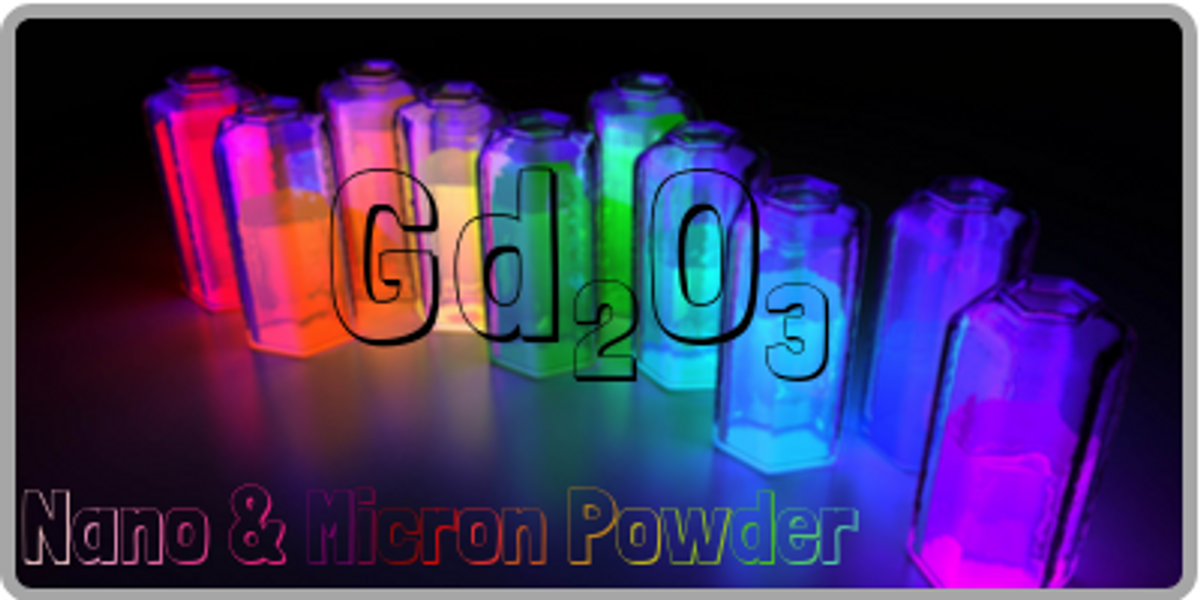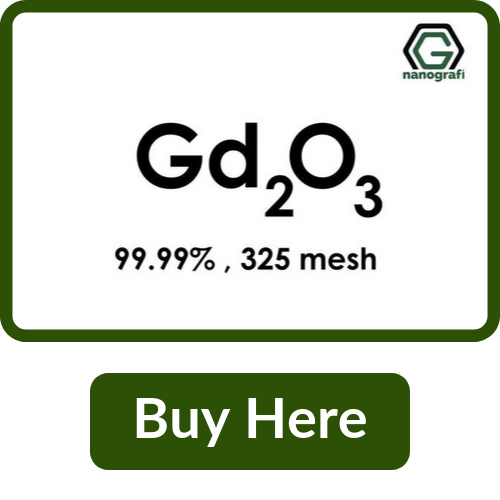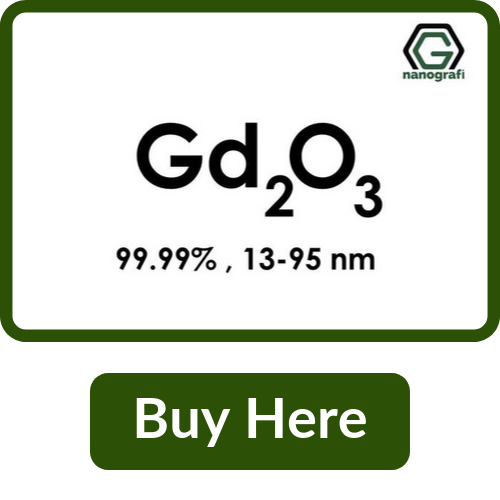Gadolinium Oxide Nano and Micron Powder: Origin, Production, Properties, Applications and More
Gadolinium Oxide is an inorganic compound having formula as Gd2O3. Gadolinium is most commonly found in nature, as it is part of the rare earth family. In Gd2O3, Gd has a degree of oxidation of three, quite common in the compounds of this element. From this compound, the pure metal can be extracted at a zero-oxidation state. Gadolinium (III) chloride (GdCl3) can also be synthesized from gadolinium oxide. In this form, gadolinium can be used as a contrast element for magnetic resonance imaging (MRI). Gadolinium Oxide Powder can be found in nano or micron form. The nanoparticles of Gadolinium Oxide have the size of approximately 10 nm, whereas the mesh size of Gadolinium Oxide micron powder is 325.
In this article, we will study the properties, structure, discovery, production, and innovative applications of Gadolinium Oxide powder.
Structure of Gadolinium oxide
There are three different modifications of Gadolinium Oxide, which are A, B and C type. The A-type has a hexagonal crystal lattice, the B type is a monoclinic distortion of the A-type, and the C type has isomorphic cubic manganese (III) oxide structure. At room temperature, it crystallizes in the C-type, the other two structures are stable only at higher temperatures. The change allotrope is observable at around 1200 °C. Beyond 2,100 °C, and up to the melting point of gadolinium oxide (2330 °C), the predominant crystalline structure is hexagonal.
Origin of Gadolinium oxide
Gadolinium oxide originates from Gadolinium which is an element having the symbol as Gd. Its atomic number is 64. It is in the group of lanthanides in the periodic table, and also belongs to the metals of the rare earth. Gadolinium is a rare element on Earth, its share of the continental crust is about 6.2 ppm.
Drawing of a Gadolinium Periodic Table representation including a TV, and Jean Charles Galissard de Marignac, the discoverer of the element. Image from The Periodic table (1865-1934) by University of Waterloo, CA.
The element occurs in many minerals of rare earth metals in different contents. Particularly high is the gadolinium content in minerals of the xenotime. In xenotime occurrences from Malaysia, the Gadolinium percentage is about 4. However, monazite also contains 1.5 to 2% of the element depending on the deposit, but in Bastnasit, the proportion is lower with 0.15 to 0.7%. Only one single mineral is known, in which gadolinium is the highest share of rare earth metal. These are the very rare uranyl carbonate lepersonite.
Production of Gadolinium oxide Powder
This compound can be obtained by thermal decomposition of hydroxides, nitrates, carbonates or oxalates. An oxide layer is also naturally formed on the surface of the metallic gadolinium. The nano or microparticles of gadolinium oxide are prepared through advanced equipment, which is used to measure the total carbon, oxygen content, size, etc. All the manufacturing processes are carried out under strict quality control. The product performance of gadolinium oxide is stable, but the cost performance is high.
Many synthetic routes lead to the production of nanoparticles formed from gadolinium oxide. The most common methods are mainly based on the precipitation of gadolinium hydroxide after reaction of the metal ion with hydroxide ions. This reaction is then followed by a heat treatment which dehydrates the hydroxide to obtain the oxide. The nanoparticles are usually covered with a protective material (heart-shell system) avoid the formation of aggregates in the medium.
In the form of nanoparticles, gadolinium oxide is a contrast element for MRI. A sample of dextran-coated gadolinium oxide particles, typically ranging from 20 to 40 nm, has a relaxivity of 4.8 s-1mM-1 per ion under a field of 7.05 T, which makes it a material of choice for such an application. It should be noted, however, that this data was obtained in the laboratory, by working with magnetic fields much higher than those of scanners commonly used in the medical field, where the intensities are rather of the order of 0.5 to 3 T.
Properties of Gadolinium oxide
Gadolinium oxide is a whiter, odorless powder and it is not soluble in water. It is hygroscopic and absorbs carbon dioxide and moisture from the atmosphere. Gd2O3 has a relatively basic reactivity compared to other metal oxides. This is evidenced by its tendency to combine with carbon dioxide (CO2) to form carbonates. Gadolinium oxide dissolves fairly well in solvents consisting of common mineral acids. However, the very low solubility of secondary compounds resulting from its reactivity, such as oxalates, fluorides, sulfates, and phosphates, limits the dissolution of gadolinium oxide. Indeed, these compounds cover and obscure its surface, making it less accessible to the solvent.
Some of the main properties of gadolinium oxide are stated below:
1. The CAS No of Gadolinium Oxide is 12064-62-9.
2. The chemical formula of gadolinium oxide nano or micron powder is Gd2O3.
3. The density of gadolinium oxide nano or micron powder is 7.407 g/cm3.
4. The molecular weight of gadolinium oxide nano or micron powder is 362.50 g/mol.
5. The melting point of gadolinium oxide nano or micron powder is 2.420 °C.
6. The gadolinium oxide powder appears white in color.
7. It is slightly hygroscopic.
8. It is not soluble in water, but slightly soluble in strong mineral acids and produces the corresponding salt.
9. Gadolinium oxide moisturizes in the air, able to absorb carbon dioxide and water in the atmosphere and metamorphism.
Application of Gadolinium Oxide Nano and Micron Powder
The main areas of applications of Gadolinium Oxide powder are given below:
- Special optical glass and plasma display panels
- Fluorescent materials, luminescence, and electroluminescent devices
- In the electric industry
- UV detectors
- Bioimaging applications
- Ferroelectric memory, cathode-ray tubes, and field emission displays
- Solid oxide fuel cell
- X-ray medical imaging with high-resolution
- As additives, catalysts, and dopants
- Scintillators and sintering aids
- Neutron converter
Let’s study a few of them in detail:
1. Gadolinium Oxide micron-powder is used to produce gadolinium yttrium garnets and optical glass having microwave applications. The gadolinium oxide micron-powder with high purity is employed for the production of phosphors for color TV tubes. Cerium oxide (in the form of ceria doped with gadolinium) forms an electrolyte having low operating temperatures and great ionic conductivity that are ideal for the economic preparation of fuel cells. This is the most abundantly available types of the terrestrial element Gadolinium, whose products are potential contrast elements for MRI.
2. The use of gadolinium oxide powder for detecting thermal neutrons has been studied by researchers and presented in the conference paper “Detection of Thermal Neutrons using Gadolinium-Oxide-based Nanocrystals”. It is to be noted that Gadolinium has the maximum thermal neutron capturing area among all the isotopes. The nanocrystal of gadolinium oxide have been doped with Cerium and Europium for this purpose. They were categorized by energy-dispersive X-ray spectroscopy, transmission electron microscopy, dynamic light scattering analysis, photoluminescence spectroscopy and steady-state UV-VIS optical absorption.
3. Like many nanoparticles with interesting optical properties, gadolinium oxide nanoparticles have been researched as a potential contrast agent for MRIs. The material showed promising results.

4. Gadolinium Oxide powder is used for making grenades of gadolinium electrolyte and optical glass.
5. Gadolinium Oxide powder is used in optical glass, electronics, and other industries.
6. Gadolinium Oxide powder is used as nuclear reactor control material of preparing raw materials.
7. It is mainly used in YAG and LGSO crystal dopants, in the inductive phosphor material, in the nuclear reactor control material, in the metal gadolinium production material, in the material of the magnetic bubble and in the addition of the optical prism.
8. Various fluorescent compounds utilize Gadolinium Oxide powder as a raw material in their production.
9. It is also used as an absorption element in nuclear fuels, atomic reactions, screen-sensitivity increasing material, magnetic bubble material, as well as many other applications in the glass, electronic and chemical industries.
10. Various luminescent devices and fluorescent materials utilize gadolinium oxide nanoparticles to function.
11. Various optical-electrical devices and applications utilize or could utilize gadolinium oxide nanopowders, including CTRs, optical glasses, display panels, and others.
12. Like many oxide nanomaterials, Gadolinium Oxide powder has been studied for its potential in solid oxide fuel cells.
13. Gadolinium oxide powder is used to produce magneto-optical storage in the form of GGG (gallium-gadolinium garnet Gd3Ga5O12) or partially substituted as GGCMZ (gallium-gadolinium-calcium-magnesium-zirconium garnet (Gd, Ca)3 (Ga, Mg, Zr)5O12).
14. Various electronic and optical-electronic devices utilize gadolinium oxide nanoparticles in their production or operation.
15. As with many other nanopowders, gadolinium oxide has shown potential as a catalyst, additive, and dopant.
Research on the bioimaging applications of Gadolinium oxide (Gd2O3) nanoparticles
The nanoparticles of Gadolinium oxide (Gd2O3) having biocompatible surfaces and paramagnetic properties are very important resources for bioimaging applications. A group of researchers from Indonesia and California State University Channle Islands (CSUCI) in US synthesized in situ pegylated Gadolinium oxide nanoparticles by liquid-phase pulsed laser ablation (PLAL) of a gadolinium target in a liquid medium of polyethylene glycol (PEG) in their 2018 study published in Journal of Science: advanced Materials and Devices. They categorized their morphology and shape with the help of Transmission Electron Microscopy (TEM), and studied the crystalline structure by scanning electron microscopy (SEM) and X-ray photoelectron spectroscopy (XPS) in addition to energy-dispersive X-ray spectroscopy (EDX) elemental mapping.
The vibrating sample magnetometry (VSM) helped to characterize the magnetic properties of Gadolinium oxide nanoparticles. The researchers found a spherical shape and a narrow distribution of crystalline Gadolinium oxide (Gd2O3) nanoparticles having the average diameters as 15, 11.60, and 6 nm, for PEG concentrations of .01,.05, and .10 Gadolinium, respectively.
So, the researchers confirmed that the partially oxidized particles of PEG are linked as carboxyl groups with Gadolinium oxide nanoparticles. Highly paramagnetic properties were revealed as a result of the complete investigation of the magnetization of Gd2O3 nanoparticles by PEG. Thus, PLAL has the ability to create a green synthesis of Gadolinium oxide, unleashing a plethora of prospects for bioimaging applications.
Thus, Gadolinium oxide is a chemical compound of the elements gadolinium and oxygen and belongs to the group of metal oxides. It is an inorganic compound having the formula as Gd2O3. It is one of the most abundantly available types of rare earth element gadolinium, whose derivatives represent possible contrast magnetic resonance representation. Gadolinium oxide powder is used as a source of fluorescent powders, host lattices, high refractive index specialty optical glasses, in nuclear reactor control rods, as contrast agents in pharmaceutical diagnostics and there are many other applications, as discussed in the article. Researchers are working on discovering the more innovative applications of Gadolinium oxide powder
Recent Posts
-
A New Approach to Obesity with Nanotechnology
Obesity stands out as a complex global health crisis that significantly increases the risk of chroni …1st Nov 2024 -
Graphene is the Word in Bionic Technology: EGNITE
Neuroprosthetic technologies have made significant advancements in recent years to enhance the qual …25th Oct 2024 -
MXenes from MAX Phases
MXenes, a group of two-dimensional materials derived from MAX phases, are gaining significant tracti …19th Oct 2024








